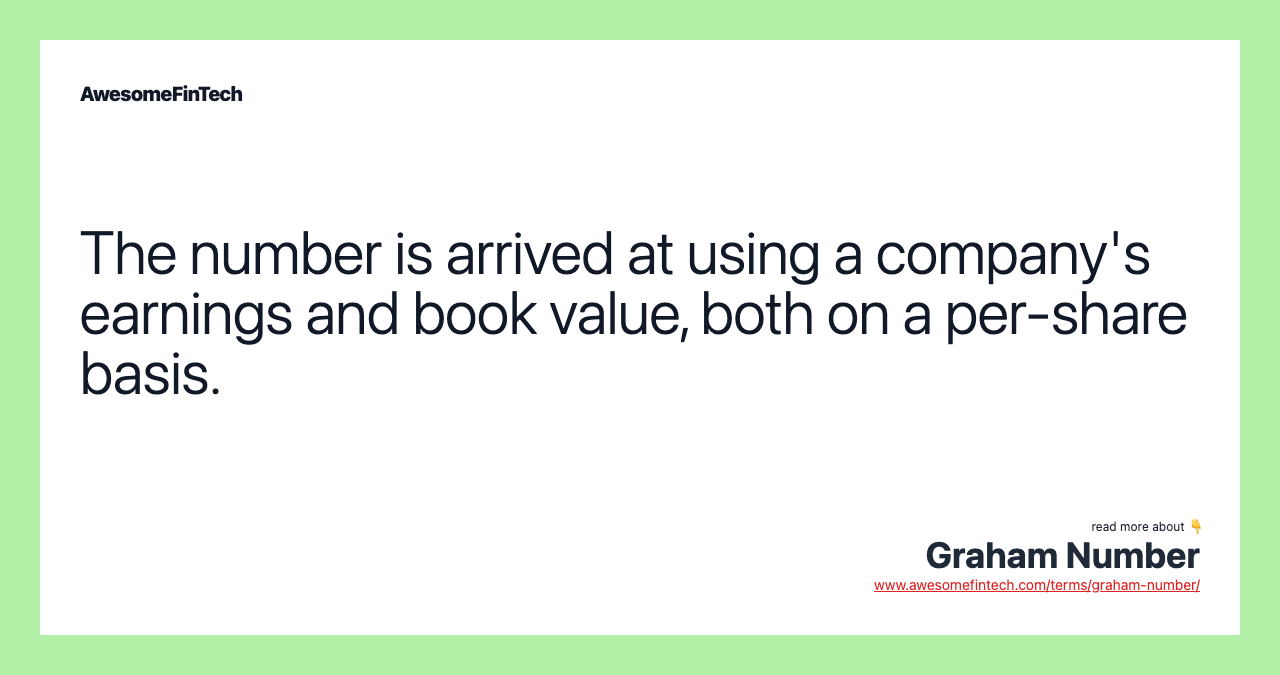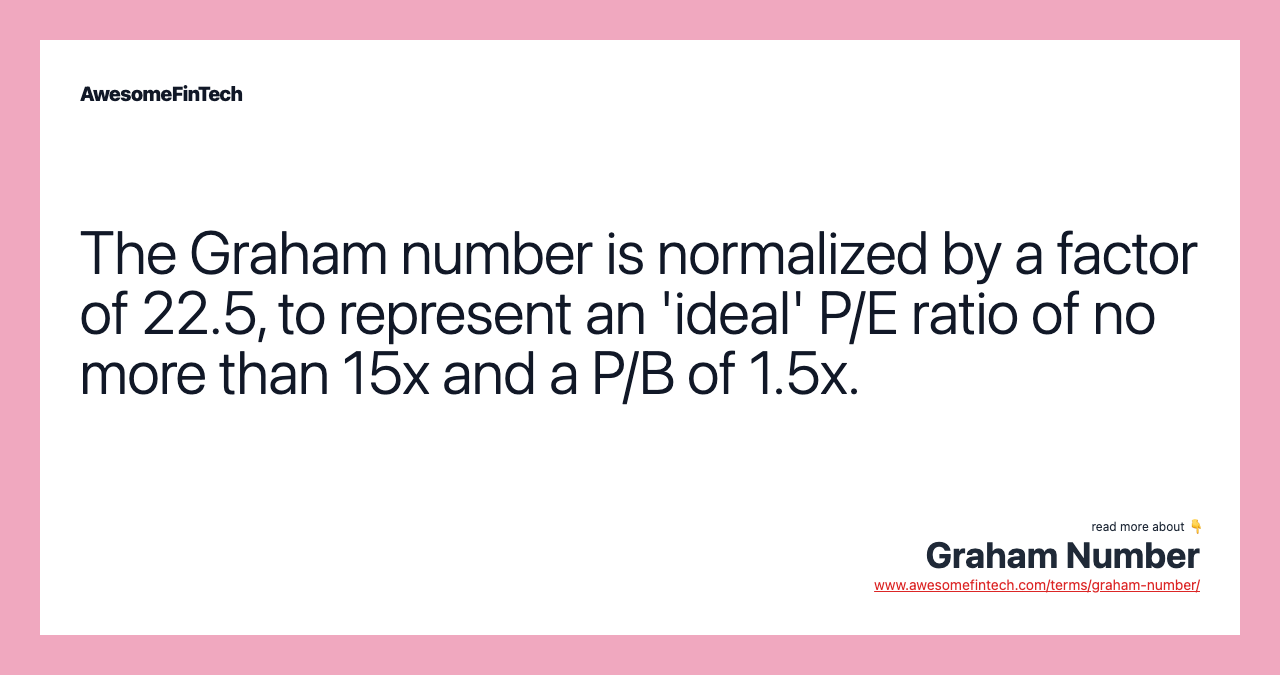Graham Number
Table of Contents What Is the Graham Number? Understanding the Graham Number Graham Number FAQs The Graham number is normalized by a factor of 22.5, to represent an 'ideal' P/E ratio of no more than 15x and a P/B of 1.5x. 22.5 × (earnings per share) × (book value per share) \\sqrt{22.5\\ \\times\\ \\text{(earnings per share)}\\ \\times\\ \\text{(book value per share)}} 22.5 × (earnings per share) × (book value per share) Earnings per share (EPS) is calculated as a company's net profit divided by the number of outstanding shares of its common stock. The Graham number (or Benjamin Graham's number) measures a stock's fundamental value by taking into account the company's earnings per share (EPS) and book value per share (BVPS). The Graham number is the upper bound of the price range that a defensive investor should pay for the stock. The 22.5 figure is included in the calculation to account for Graham's belief that the price-to-earnings (P/E) ratio should not be over 15x and the price-to-book (P/B) ratio should not be over 1.5x (thus, 15 x 1.5 = 22.5). The Graham number can thus be alternatively calculated as: 15 × 1.5 × ( net income shares outstanding ) × ( shareholders’ equity shares outstanding ) \\sqrt{15\\ \\times\\ 1.5\\ \\times\\ \\left(\\frac{\\text{net income}}{\\text{shares outstanding}}\\right)\\ \\times\\ \\left(\\frac{\\text{shareholders' equity}}{\\text{shares outstanding}}\\right)} 15 × 1.5 × (shares outstandingnet income) × (shares outstandingshareholders’ equity) Essentially, this second method of calculation is equivalent to the first, wherein EPS = net income/shares outstanding, and book value is another term for shareholders’ equity. The Graham number takes a company's per-share metrics and normalizes it based on a recommended upward limit for value investors of 15x P/E and 1.5x P/B. Benjamin Graham is one of the founding fathers of value investing, and a financial guru to many famous value investors such as Warren Buffett.

What Is the Graham Number?
The Graham number (or Benjamin Graham's number) measures a stock's fundamental value by taking into account the company's earnings per share (EPS) and book value per share (BVPS).
The Graham number is the upper bound of the price range that a defensive investor should pay for the stock. According to the theory, any stock price below the Graham number is considered undervalued and thus worth investing in.




The Formula for Graham Number
22.5 × (earnings per share) × (book value per share) \sqrt{22.5\ \times\ \text{(earnings per share)}\ \times\ \text{(book value per share)}} 22.5 × (earnings per share) × (book value per share)
Understanding the Graham Number
The Graham number is named after the "father of value investing," Benjamin Graham. It is used as a general test when trying to identify stocks that are currently selling for a good price. The 22.5 figure is included in the calculation to account for Graham's belief that the price-to-earnings (P/E) ratio should not be over 15x and the price-to-book (P/B) ratio should not be over 1.5x (thus, 15 x 1.5 = 22.5).
The Graham number can thus be alternatively calculated as:
15 × 1.5 × ( net income shares outstanding ) × ( shareholders’ equity shares outstanding ) \sqrt{15\ \times\ 1.5\ \times\ \left(\frac{\text{net income}}{\text{shares outstanding}}\right)\ \times\ \left(\frac{\text{shareholders' equity}}{\text{shares outstanding}}\right)} 15 × 1.5 × (shares outstandingnet income) × (shares outstandingshareholders’ equity)
Essentially, this second method of calculation is equivalent to the first, wherein EPS = net income/shares outstanding, and book value is another term for shareholders’ equity.
According to Benjamin Graham, the current price should not be more than 1 1/2 times the book value last reported. However, a multiplier of earnings below 15 could justify a correspondingly higher multiplier of assets. As a rule of thumb, the product of the multiplier times the ratio of price to book value should not exceed 22.5.
Example of the Graham Number
For example, if the earning per share for a single share of company ABC is $1.50, the book value per share is $10, the Graham number would be 18.37. ((22.5*1.5*10)1/2= 18.37). Again, $18.37 is the maximum price an investor should pay for a share of ABC, according to Graham. If ABC is priced at $16, it is attractive; if priced at $19, it should be avoided.
Limitations of the Graham Number
The calculation for the Graham number does leave out many fundamental characteristics, which are considered to comprise a good investment, such as management quality, major shareholders, industry characteristics, and the competitive landscape.
With regard to stocks and equity instruments, fundamental analysis is a method of determining the value that focuses on key metrics and economic indicators, such as revenues, earnings, where an industry is in its cycle, return on equity (ROE), and profit margins.
Fundamental analysis relies on a company’s financial statements. One of the most famous and successful fundamental analysts, Warren Buffett — aka "the Oracle of Omaha" — is famous for successfully employing fundamental analysis. Warren Buffett was both a student and employee of Benjamin Graham. The fundamental method of security analysis is considered to be the opposite of technical analysis.
What Is a Good Graham's Number?
Graham's number will always present a maximum stock price given a company's EPS and BVPS. As a result, any stock price below that figure should signal a good buy for a value investor.
How Does the Graham Number Work in Value Investing?
The Graham number takes a company's per-share metrics and normalizes it based on a recommended upward limit for value investors of 15x P/E and 1.5x P/B.
Who Was Benjamin Graham?
Benjamin Graham is one of the founding fathers of value investing, and a financial guru to many famous value investors such as Warren Buffett. Graham's philosophy was to closely examine a company's financial statements to identify undervalued opportunities. His book, The Interpretation of Financial Statements is widely regarded as foundational for value investing.
Related terms:
Benjamin Graham
Benjamin Graham was an influential investor who is regarded as the father of value investing. read more
Benjamin Method
The investment approach that aims to follow the strategies implemented by Benjamin Graham. read more
Book Value : Formula & Calculation
An asset's book value is equal to its carrying value on the balance sheet, and companies calculate it by netting the asset against its accumulated depreciation. read more
Book Value Per Share (BVPS)
Book value per share (BVPS) measures a company's book value on a per-share basis. read more
Earnings Per Share (EPS)
Earnings per share (EPS) is the portion of a company's profit allocated to each outstanding share of common stock. Earnings per share serve as an indicator of a company's profitability. read more
Fundamental Analysis
Fundamental analysis is a method of measuring a stock's intrinsic value. Analysts who follow this method seek out companies priced below their real worth. read more
Net Current Asset Value Per Share (NCAVPS)
Net current asset value per share (NCAVPS) is a measure created by Benjamin Graham as one means of gauging the attractiveness of a stock. read more
Net-Net
Net-net is a value investing technique developed by Benjamin Graham in which a company is valued based solely on its net current assets. read more
Price-to-Earnings (P/E) Ratio
The price-to-earnings (P/E) ratio is the ratio for valuing a company that measures its current share price relative to its per-share earnings. read more
Price-To-Book Ratio (P/B Ratio)
The price-to-book ratio (P/B ratio) evaluates a firm's market value relative to its book value. read more